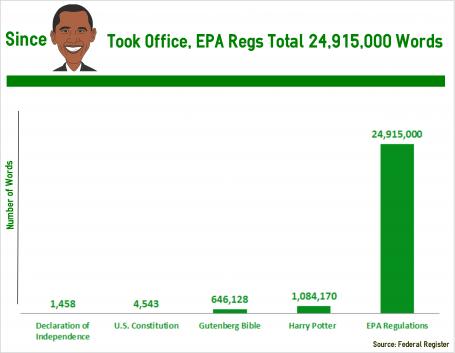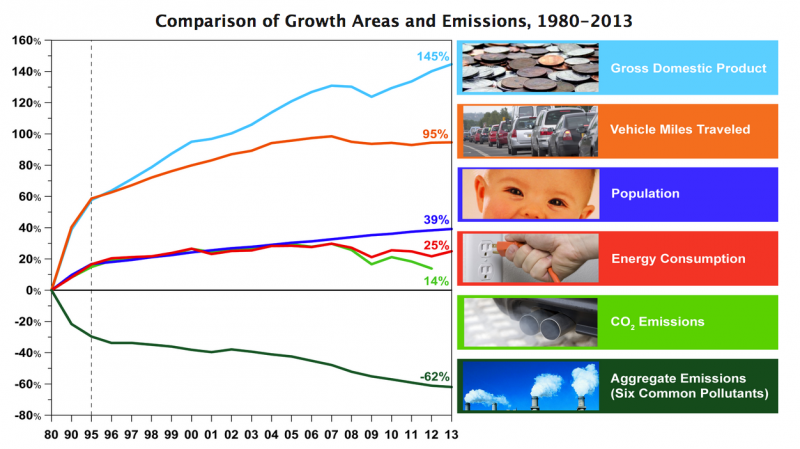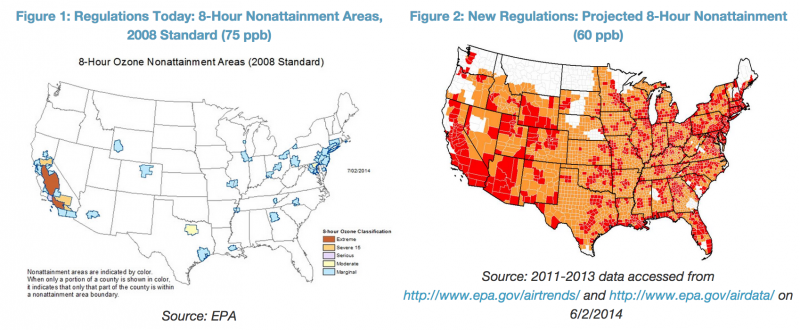Ozone Rule Proves it is Time for Liberals to Compromise on EPA
Ozone Rule Proves it is Time for Liberals to Compromise on EPA
By: Patrick Hedger- Policy Director, American Encore

The last several years in Washington have been defined by the lack of compromise. No where is this polarization between liberals and conservatives more apparent than in the debate over the roll of environment regulation. Since the Obama administration has taken office, exceptionally large regulations, by multiple metrics, have been promulgated and finalized by the Environmental Protection Agency (EPA). Examples include the Utility MACT rule, the Clean Power Plan, and the recently announced revisions to the ground-level ozone standards. This has irked conservatives that have characterized these regulations as needless and expensive overreach at a time when the economy is still struggling to reach pre-recession sustainability. Liberals, on the other hand, seem to find each of these regulations to be critically important to the health and safety of society. While some regulations indeed have undeniable merit, recent activity at the EPA suggests that it may be time for liberals to compromise on their ardent stance in support of the controversial agency.
The health of the environment is a difficult issue to tackle from the conservative perspective of advocating for limited government. In a perfect world, private property rights would solve the majority of the problems of pollution, with property owners bringing legal challenges against polluters for their role in whatever endangerment of health and property has occurred. Plus, the specter of being held accountable in the courts would also deter potential polluters. Certainly this is a model that should be expanded to the fullest extent possible.
The trouble occurs when considering how to protect the environment outside of privately held property, namely in large public commons such as airspace and the oceans. For this reason, Congress has delegated power to the EPA through laws such as the Clean Air Act and the Clean Water Act. Subsequently, the EPA passed regulations aimed at cleaning up the nation’s environment. Some regulations have been costly, other have been quick fixes. Some were common sense, others convoluted. There are too many EPA regulations on the books to even begin debating each and everyone of them at this time, a point of debate in and of itself.
However, on this point there is no argument: For a myriad of reasons, the environment is cleaner by almost every measure today than it was 44 years ago this week, when the EPA was founded. That being said, the cleanliness of our nation’s environment, a point of pride of the EPA, is also a point that raises serious questions about the organizations ongoing operations. If the environment is getting cleaner, why is the EPA getting bigger? According to the Office of Management and Budget, between now and 2019, the EPA’s annual budget is projected to grow by another $400 million, to $8.48 billion.
Further, why are proposed EPA regulations becoming more onerous and expensive?
The situation defies logic; equivalent to expanding the police force in a ghost town. Case in point is the recent announcement by the EPA to revise the national ground-level ozone standards.
These standards regulate the concentration of ozone on a county by county basis across the country. Ground-level ozone is not to be confused the ozone layer in the upper atmosphere, the focus of environmental alarmists a generation ago. Ground-level ozone is the byproduct of the chemical reaction of nitrogen oxides and volatile organic compounds, known as ozone precursors, with sunlight. These precursors are emitted from both anthropogenic (man-made) sources, like automobiles and factories, and natural sources, such as normal plant life and wildfires.
The EPA has proposed lowering the acceptable ground-level ozone concentration from the current standard of 75 parts per billion (ppb) to 60 pbb. Critics have countered, raising serious concerns about this proposal. The National Association of Manufacturers (NAM) has noted that this new rule could potentially be the most expensive regulation in US history. Paraphrasing their comprehensive report on the proposed ozone standards, here’s why:
Ground-level ozone regulation is nothing new. The EPA has been regulating the acceptable level of ozone in the air for many years. Thus, controls have been put in place which have significantly reduced local anthropogenic emissions of ozone precursors. As a result, the majority of existing ozone pollution in the country is actually from natural and non-local sources, including from overseas. This has left industries scratching their heads. How are they supposed to reduce the presence of ozone precursors that they aren’t emitting in the first place?
The legitimacy of this question has been verified by a recent study conducted by the American Action Forum. The study found that 100 national and state parks across the United States, devoid of factories and sparsely traversed by vehicles, would no longer be in compliance with this EPA air pollution standard at the proposed level.
Further, at the current level of 75 ppb, nearly the entire country is in attainment with ground-level ozone standards. By reducing the standard to the proposed 60 ppb, nearly the entire country would be thrown out of attainment. With the majority of the reduction required coming from unknown sources, as noted by the NAM study, it would be difficult for businesses in any part of the country to invest in and expand manufacturing related activities. Further, with so much of the rural United States exiting attainment under such a standard, the recent surge in oil and gas exploration, responsible for lowering energy prices of late, would be severely curtailed.
The economic cost of all this? The NAM study estimates a reduction in annual GDP averaging $270 billion per year, totaling $3.4 trillion by 2040. Further, American households will lose over $1,500 in disposable income each year as the job market is suppressed to the extent of 2.9 million jobs annually.
In short, arguably the most expensive regulation in US history is being imposed on Americans in order to combat ground-level ozone pollution that they are largely not responsible for creating. How is such a blatantly absurd situation now a reality? Again, it is tied to the prevailing illogic within which the EPA now operates.
Conservatives are willing to accept that regulation can be effective to a certain extent and help address the undeniable problem of protecting public goods and commons. Yet at the same time, after 44 years, and with significant and tangible progress made in regards to the health of the nation’s environment, it is time for liberals to stop defending each and every new function and newly appropriated dollar to the EPA as a dire necessity. Instead liberals ought to accept that, at a certain point, returns diminish on increasing regulation. With the promulgation of these new ozone regulations, along with a handful of other high-profile rules in the pipeline, it is clear that we are well beyond this point.









